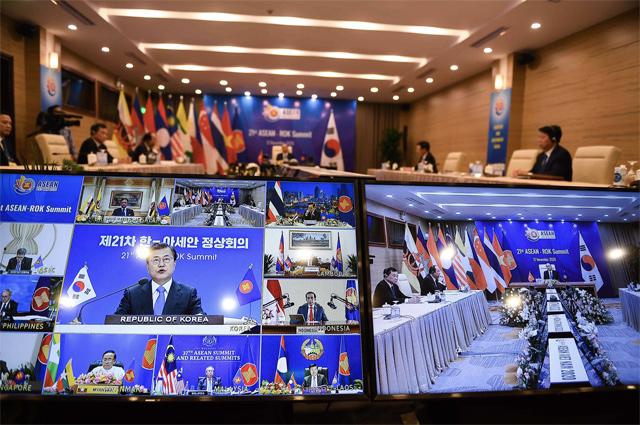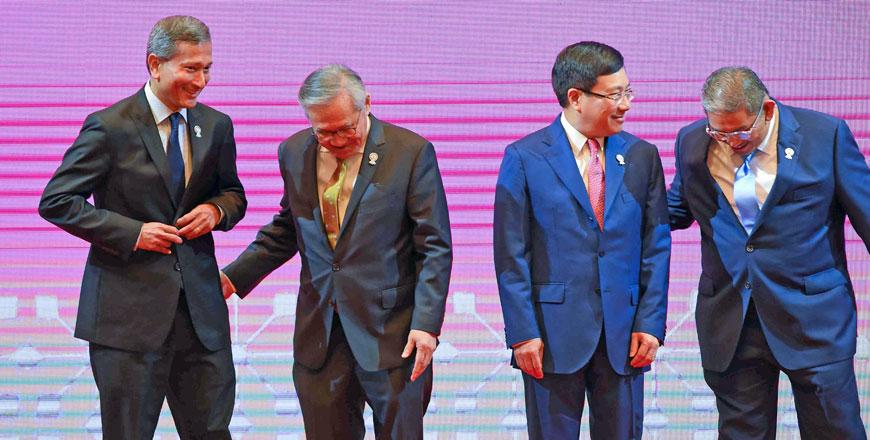You are here
Huge China-backed trade pact to be signed at Southeast Asian summit
By AFP - Nov 12,2020 - Last updated at Nov 12,2020

South Korean President Moon Jae-in (C on left screen) addresses counterparts at the ASEAN-South Korea Summit of the Association of Southeast Asian Nations (ASEAN), on a live video conference held online due to the COVID-19 coronavirus pandemic, in Hanoi on Thursday (AFP photo)
HANOI, Vietnam — Fifteen Asia-Pacific countries are set to sign an enormous free trade deal at an online summit that started on Thursday, with the pact seen as a coup for China in extending its influence across the region.
Once signed, the Regional Comprehensive Economic Partnership (RCEP) will be the world's largest trade pact in terms of GDP, according to analysts.
The pact, which was first proposed in 2012 and viewed as a Chinese-led rival to a now-defunct US trade initiative, loops in 10 Southeast Asian economies along with China, Japan, South Korea, New Zealand and Australia.
"After eight years of negotiating with blood, sweat and tears, we have finally come to the moment where we will seal the RCEP Agreement per cent this Sunday," said Malaysia's trade minister Mohamed Azmin Ali, ahead of the virtual meeting.
Vietnam's Prime Minister Nguyen Xuan Phuc also confirmed the pact would be signed this week during opening remarks at the online summit.
India had been due to sign the pact but pulled out last year over concerns about cheap Chinese goods entering the country, though it can join at a later date if it reverses its position.
The RCEP — whose members account for around 30 of global GDP — would be a "major positive step forward for trade and investment liberalisation" in the region, said Rajiv Biswas, Asia Pacific chief economist at global business consultancy IHS Markit.
"RCEP will be the world's biggest free trade area measured in terms of GDP," he added.
The pact's expected signing comes as the 10 members of the Association of Southeast Asian Nations (ASEAN) fight to mitigate the heavy cost of the coronavirus, which has ravaged their economies and left many battling a severe public health crisis.
Thorny issues
The pact is also seen as a mechanism for China to draft the rules of Asia-Pacific trade, following years of US retreat under President Donald Trump.
"It certainly lends advantage to China's geopolitical ambitions," said Alexander Capri, a trade expert at the National University of Singapore Business School.
But US President-elect Joe Biden may engage more actively with the region, Capri added, in much the same way as former President Barack Obama did.
"Think of the Biden administration as sort of a continuation of the Obama administration, certainly when it comes to the pivot to Asia," he said.
While the region waits to see how its relationship with the US will unfold, it is battling several other thorny issues — including disputes over the South China Sea.
The flashpoint waters — claimed in their entirety by Beijing but also contested by Vietnam, the Philippines, Malaysia, Brunei and Taiwan — will also be on the agenda at the summit.
But as several nations battle serious Covid-19 outbreaks, and with many promised priority access to Chinese-made vaccines, a stand against Beijing is seen as unlikely.
Instead, the focus will be on economic development in the bloc, with many of its tourism and export-reliant countries suffering badly.
"The road ahead is not a bed of roses," said Vietnamese President Nguyen Phu Trong at the summit, warning that leaders would be expected to work together to control infections and support people who are suffering.
The RCEP could help ease the financial pain, said Kaewkamol Pitakdumrongkit, an assistant professor at the Centre of Multilateralism Studies in Singapore's S. Rajaratnam School of International Studies.
"In the light of Covid-19, RCEP could enable ASEAN to bounce back more quickly as such a deal allows firms to diversify their supply chains and increase resiliency of the regional economies," she added.
Related Articles
SINGAPORE/HANOI — Fifteen Asia-Pacific countries on Sunday signed the world’s biggest free trade deal, seen as a huge coup for China in exte
WASHINGTON — US President Barack Obama took a dig at China Saturday as he defended the new Trans-Pacific Partnership (TPP) free-trade deal,
BANGKOK — Southeast Asian leaders gathered in Bangkok on Saturday determined to drive forward the world’s largest commercial pact, with the
















